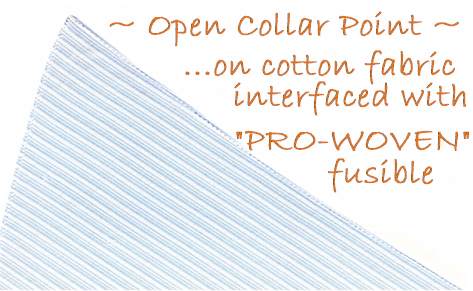I enjoy using center-gathered strips to use as a ruffle embellishment (often called a "Euro-Ruffle"). The ruffled strip on the top pictured above is for my little friend Julianna, age 3, but I have used this same technique with narrow ruffles around necklines or sleeves on adult garments. The ways to use this embellishment are limited only by your imagination.
In this tutorial, I will show you how to make a center ruffled strip, without having to pull any gathering threads!
You can click each photo to enlarge it, then click the << BACK button of your browser to return to this page.
First, start with a strip of woven or knit fabric. I have found that any width from 3/4" to 3" works well when using the finished ruffle to embellish a shirt or top, as pictured above. However, I have seen wider ruffles used by other designers that look very nice...it's up to the look you want. I usually tear my fabric strips on the cross-grain of the fabric when using a woven fabric, or I cut the strips with a rotary-cutter when using a knit fabric. Sometimes I leave the edges raw, or I finish them as I showed you in
THIS POST.
The top pictured above was embellished with 1-3/4" strips of woven fabric that have been finished
like this--
Since the strips will be gathered, you may need to start with more than one strip so that it will be long enough. I find that it is easier to join them
before gathering, as shown below--
After stitching them together as shown above, trim off the the excess "triangle", leaving a 1/4" seam allowance. Treat the seam allowance with a product like "Fray Check" to prevent it from raveling, then open up the strip so that it is straight , and press. It should look like this--
Don't be worried if the edges do not meet exactly! A small mismatch will never be seen after the strip is gathered...trust me :)
Now this is where the "no thread pulling" gathering happens. I found this nifty presser foot....called a "
Gathering Foot" at an
online store. A sewing friend has told me that this foot is also known as a "Shirring Foot". It was about 10 bucks, and worth every penny in my opinion. This is what it looks like:
Maybe you already have one among the presser feet that came with your machine.
The key to using the
Gathering Foot is to increase the foot pressure, lengthen your stitch to about 3, and to increase your upper thread tension as high as it will go. Test a scrap strip of fabric by stitching down the center of the strip. If your test strip gathers up nicely like this one, you are ready to gather the strip you are using for your embellishment--
If your test strip does NOT gather well, like this one....
...there are 2 things you can do. You can try increasing the UPPER (top) thread tension by wrapping the thread twice though the first threading guide on your machine. This how that looks on my machine--
Or, you can place your fingers right behind the foot as you sew, preventing the fabric from moving. Once you cannot hold the "bunch" of fabric behind the foot any longer, release, and just place your finger behind the foot again. Repeat until the entire strip is gathered. Here is a photo of this technique--
When you are finished gathering your strip, it will look like a twisted ruffle, like this--
To make it MUCH easier to work with, press the strip as straight and flat as you can, as shown below. Don't worry about crushing it, the strip will ruffle up again after you wash the finished garment...trust me :)
Now the ends of the ruffled strip need to be clean-finished. You can do this before gathering the strip, or after it is gathered. It is just my preference to do it after gathering...I've found that it makes the finished strip look ruffled right to the ends, rather than looking "flat" on the ends. Just turn about 1/4" twice to the wrong side and stitch, as shown below.
So, now you have a lovely "Euro-Ruffle" that you can easily arrange into any shape, like this one that I've arranged into a simple "S" shape.
Embellishing your garment with these ruffles is easy. Just use a narrow zig-zag, and stitch along the center covering the straight gather stitching as you sew it to your garment. Some designers embellish their garments before assembling them, others apply the ruffles after the garment is finished. For tops, I have found it easier to apply the ruffle after I stitch one shoulder seam, and one side seam. Then I can extend the ruffle easily to the back of the garment while it is flat. I usually arrange mine in a random way like the top pictured at the top of this tutorial, but you can mark a line on your garment and follow it as you attach the ruffle. It's all up to you how you use your lovely ruffles !
But the best thing about this technique is not having to try to gather a long strip by pulling threads, isn't it?
Labels: Sewing Tutorials


 HotPatterns #1071,
HotPatterns #1071,
















 This is a quick stylish variation on a drape-front (true Cowl) silhouette that can be done in just minutes!
This is a quick stylish variation on a drape-front (true Cowl) silhouette that can be done in just minutes! As shown In photo #2, turn the garment inside out and flip the facing up to expose the wrong side of front of the top.
As shown In photo #2, turn the garment inside out and flip the facing up to expose the wrong side of front of the top.



